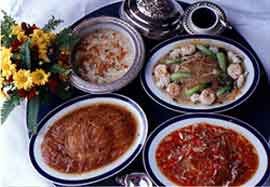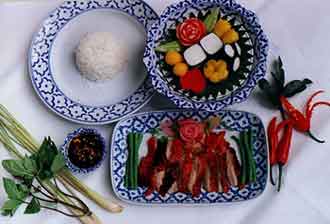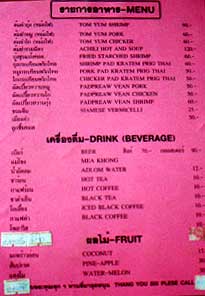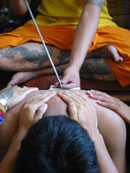Eating in Thailand
When most people think of Thai food, they think of spicy dishes that have the ability to knock your socks off. While this is in part true, Thailand has a variety of dishes suitable for most any palate. All visitors are bound to find something they like. I am the most finicky of eaters out there and even I have found some surprising delights. Thai food provides a wealth of new tastes and brings with it different table manners.
Thailand’s vast agricultural ability provides fresh vegetables and fruit throughout the year and also means that Thai food is almost always cooked with fresh ingredients. Due to contact with China, India, and Europe, the Thai kitchen has evolved and incorporated new ingredients over time.
When I think of the Thai kitchen, fish sauce, chili pepper, rice, noodles, spices and curries are the first things that spring to mind. Fresh herbs, such as lemongrass, coriander, ginger, basil, garlic, black pepper, turmeric, as well as sugar, shrimp paste, coconut milk, and salt are staple items in most kitchens. Fish, poultry, and pork can be found in many dishes. Beef is also used but is not as popular.
milk, and salt are staple items in most kitchens. Fish, poultry, and pork can be found in many dishes. Beef is also used but is not as popular.
Thais are fond of things that are both sweet and sour. Fruit is often dipped into salt or chili pepper. To my surprise I have witnessed people dumping salt into their glasses of Coke to achieve this effect. Condiments are an important part of any meal and include fresh cut chilies, fish sauce, chili sauce, sugar, salt, and black pepper.
Rice is the cornerstone of any meal. There is a huge variety and quantity of rice residing in any grocery store. Very glutinous rice known as sticky rice is rolled into small balls, dipped into the main dishes, and eaten with the right hand. This kind of rice originates from Laos and is more popular in the north and northeast of Thailand.
The word ‘to eat’ in Thai literally translates to ‘eat rice’ (gin khaow). It is seen as polite to eat a plain spoonful of rice before beginning your meal as an acknowledgement that rice is the most important part of the meal.
meal as an acknowledgement that rice is the most important part of the meal.
Noodles also abound and come in a mind-boggling array of shapes, sizes, and textures. There is also a lot of Chinese-style food due to the large ethnic Chinese population living in Thailand. This is one of the less-spicy eating options.
Up to 40 varieties of chili peppers are available in Thailand, ranging from the large and harmless to the small hard-to-spot torpedo-shaped fireballs otherwise known as ‘mouse dropping peppers’ (phrik khii nuu). For people who believe they can eat spicy food, Thailand may provide a new definition of the word.
A Thai meal is most often informal and communal. A meal can be eaten while sitting on the ground on a bamboo mat or while sitting at a table. As the food arrives, the eating begins. It is common to share several different dishes at a time and these dishes are eaten in the order each individual wishes.
Thais eat most things by using a fork to push the food onto a tablespoon. Soups are eaten with a spoon and chopsticks. To eat with a fork during a Thai meal is seen as being as odd as licking your knife. It is also polite to not eat everything on your plate. Over-ordering at restaurants is commonplace and is a way to be seen as both polite and generous.
push the food onto a tablespoon. Soups are eaten with a spoon and chopsticks. To eat with a fork during a Thai meal is seen as being as odd as licking your knife. It is also polite to not eat everything on your plate. Over-ordering at restaurants is commonplace and is a way to be seen as both polite and generous.
A typical Thai lunch or evening meal may consist of a curry, soup, a spicy salad, a bowl of rice, and fresh fruit or sweets for dessert. Thailand provides a variety of sweet desserts. A rice dish or soup is commonly eaten for breakfast.
The Thai word for sweets is “khanom”. Khanom are made out of a variety of different ingredients. I am a big fan of a cake-like one which is made of rice flour, coconut milk and palm sugar. This particular khanom is called “khanom taan”. I offered to share my discovery with another foreigner here and he exclaimed, “This tastes like a phonebook!” thus proving that Thai food, like all food, is a matter of taste.
Noodles, tapioca, fruit, or sweet jelly cubes are often set on top of cold sweetened coconut milk as another popular dessert. Coconut custards and jellies make up another selection of sweets and these are very often wrapped in banana leaves or rolled into balls. I once ate one that contained fish as an ingredient, a startling experience for sure.
I believe that if one were to be adventurous, they would never run out of things to sample in Thailand. Between the street vendors providing a stunning array of food, there is also an abundance of restaurants, and of course a good home-cooked meal from a Thai mom.
If you are interested in checking out both Thai and non-Thai weekly recipes, I suggest you have a look at http://www.bangkokpost.com/realtime/cooktime.html. Happy New Year and happy eating!
